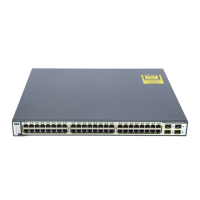33-7
Catalyst 3750 Switch Software Configuration Guide
78-16180-02
Chapter 33 Configuring EtherChannels
Understanding EtherChannels
LACP Modes
Table 33-2 shows the user-configurable EtherChannel LACP modes for the channel-group interface
configuration command.
Both the active and passive LACP modes enable ports to negotiate with partner ports to an EtherChannel
based on criteria such as port speed and, for Layer 2 EtherChannels, trunking state and VLAN numbers.
Ports can form an EtherChannel when they are in different LACP modes as long as the modes are
compatible. For example:
• A port in the active mode can form an EtherChannel with another port that is in the active or passive
mode.
• A port in the passive mode cannot form an EtherChannel with another port that is also in the passive
mode because neither port starts LACP negotiation.
LACP Interaction with Other Features
The DTP and the CDP send and receive packets over the physical ports in the EtherChannel. Trunk ports
send and receive LACP PDUs on the lowest numbered VLAN.
In Layer 2 EtherChannels, the first port in the channel that comes up provides its MAC address to the
EtherChannel. If this port is removed from the bundle, one of the remaining ports in the bundle provides
its MAC address to the EtherChannel. For Layer 3 EtherChannels, the MAC address is allocated by the
stack master as soon as the interface is created through the interface port-channel global configuration
command.
LACP sends and receives LACP PDUs only from ports that are up and have LACP enabled for the active
or passive mode.
Load Balancing and Forwarding Methods
EtherChannel balances the traffic load across the links in a channel by reducing part of the binary pattern
formed from the addresses in the frame to a numerical value that selects one of the links in the channel.
EtherChannel load balancing can use MAC addresses or IP addresses, source or destination addresses,
or both source and destination addresses. The selected mode applies to all EtherChannels configured on
the switch. You configure the load balancing and forwarding method by using the port-channel
load-balance global configuration command.
Table 33-2 EtherChannel LACP Modes
Mode Description
active Places a port into an active negotiating state in which the port starts negotiations with other
ports by sending LACP packets.
passive Places a port into a passive negotiating state in which the port responds to LACP packets
that it receives, but does not start LACP packet negotiation. This setting minimizes the
transmission of LACP packets.
on Forces a port to channel without PAgP or LACP. With the on mode, a usable EtherChannel
exists only when a port group in the on mode is connected to another port group in the on
mode. This is the only setting that is supported when the EtherChannel members are from
different switches in the switch stack (cross-stack EtherChannel).

